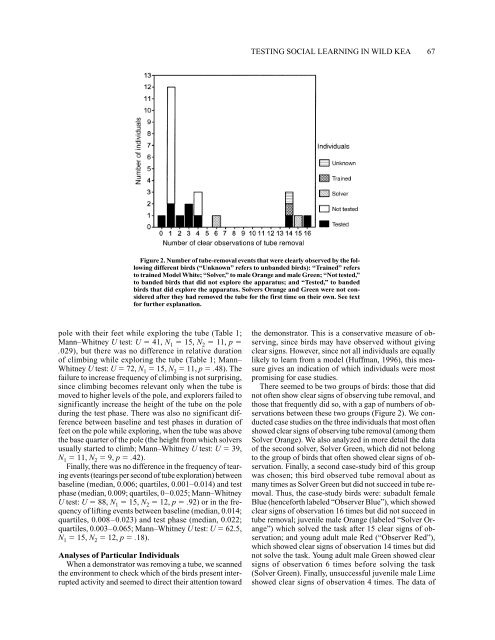Nestor notabilis - Kea Conservation Trust
Nestor notabilis - Kea Conservation Trust
Nestor notabilis - Kea Conservation Trust
You also want an ePaper? Increase the reach of your titles
YUMPU automatically turns print PDFs into web optimized ePapers that Google loves.
pole with their feet while exploring the tube (Table 1;<br />
Mann–Whitney U test: U � 41, N 1 � 15, N 2 � 11, p �<br />
.029), but there was no difference in relative duration<br />
of climbing while exploring the tube (Table 1; Mann–<br />
Whitney U test: U � 72, N 1 � 15, N 2 � 11, p � .48). The<br />
failure to increase frequency of climbing is not surprising,<br />
since climbing becomes relevant only when the tube is<br />
moved to higher levels of the pole, and explorers failed to<br />
significantly increase the height of the tube on the pole<br />
during the test phase. There was also no significant difference<br />
between baseline and test phases in duration of<br />
feet on the pole while exploring, when the tube was above<br />
the base quarter of the pole (the height from which solvers<br />
usually started to climb; Mann–Whitney U test: U � 39,<br />
N 1 � 11, N 2 � 9, p � .42).<br />
Finally, there was no difference in the frequency of tearing<br />
events (tearings per second of tube exploration) between<br />
baseline (median, 0.006; quartiles, 0.001–0.014) and test<br />
phase (median, 0.009; quartiles, 0–0.025; Mann–Whitney<br />
U test: U � 88, N 1 � 15, N 2 � 12, p � .92) or in the frequency<br />
of lifting events between baseline (median, 0.014;<br />
quartiles, 0.008–0.023) and test phase (median, 0.022;<br />
quartiles, 0.003–0.065; Mann–Whitney U test: U � 62.5,<br />
N 1 � 15, N 2 � 12, p � .18).<br />
Analyses of Particular Individuals<br />
When a demonstrator was removing a tube, we scanned<br />
the environment to check which of the birds present interrupted<br />
activity and seemed to direct their attention toward<br />
TESTING SOCIAL LEARNING IN WILD KEA 67<br />
Figure 2. Number of tube-removal events that were clearly observed by the following<br />
different birds (“Unknown” refers to unbanded birds): “Trained” refers<br />
to trained Model White; “Solver,” to male Orange and male Green; “Not tested,”<br />
to banded birds that did not explore the apparatus; and “Tested,” to banded<br />
birds that did explore the apparatus. Solvers Orange and Green were not considered<br />
after they had removed the tube for the first time on their own. See text<br />
for further explanation.<br />
the demonstrator. This is a conservative measure of observing,<br />
since birds may have observed without giving<br />
clear signs. However, since not all individuals are equally<br />
likely to learn from a model (Huffman, 1996), this measure<br />
gives an indication of which individuals were most<br />
promising for case studies.<br />
There seemed to be two groups of birds: those that did<br />
not often show clear signs of observing tube removal, and<br />
those that frequently did so, with a gap of numbers of observations<br />
between these two groups (Figure 2). We conducted<br />
case studies on the three individuals that most often<br />
showed clear signs of observing tube removal (among them<br />
Solver Orange). We also analyzed in more detail the data<br />
of the second solver, Solver Green, which did not belong<br />
to the group of birds that often showed clear signs of observation.<br />
Finally, a second case-study bird of this group<br />
was chosen; this bird observed tube removal about as<br />
many times as Solver Green but did not succeed in tube removal.<br />
Thus, the case-study birds were: subadult female<br />
Blue (henceforth labeled “Observer Blue”), which showed<br />
clear signs of observation 16 times but did not succeed in<br />
tube removal; juvenile male Orange (labeled “Solver Orange”)<br />
which solved the task after 15 clear signs of observation;<br />
and young adult male Red (“Observer Red”),<br />
which showed clear signs of observation 14 times but did<br />
not solve the task. Young adult male Green showed clear<br />
signs of observation 6 times before solving the task<br />
(Solver Green). Finally, unsuccessful juvenile male Lime<br />
showed clear signs of observation 4 times. The data of












